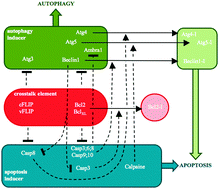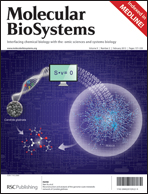A cellular stress-directed bistable switch controls the crosstalk between autophagy and apoptosis†
Abstract
Decision-making between life and death is one of the most important tasks of cells to maintain their genetic integrity. While the surviving mechanism is driven by Beclin1-dependent autophagy, the suicide processes are controlled by caspases-mediated apoptosis. Interestingly, both these processes share regulators such as Bcl2 and influence each other through feedback loops. The physiological relevance of the crosstalk between autophagy and apoptosis is still unclear. To gain system level insights, we have developed a mathematical model of the autophagy–apoptosis crosstalk. Our analysis reveals that a combination of Bcl2-dependent regulation and feedback loops between Beclin1 and caspases robustly enforces a sequential activation of cellular responses depending upon the intensity and duration of stress levels. The amplifying loops for caspases


 Please wait while we load your content...
Please wait while we load your content...